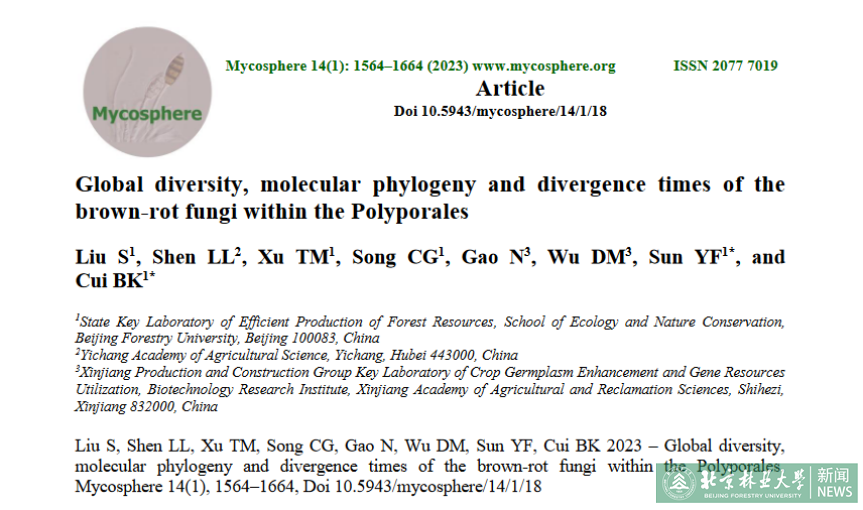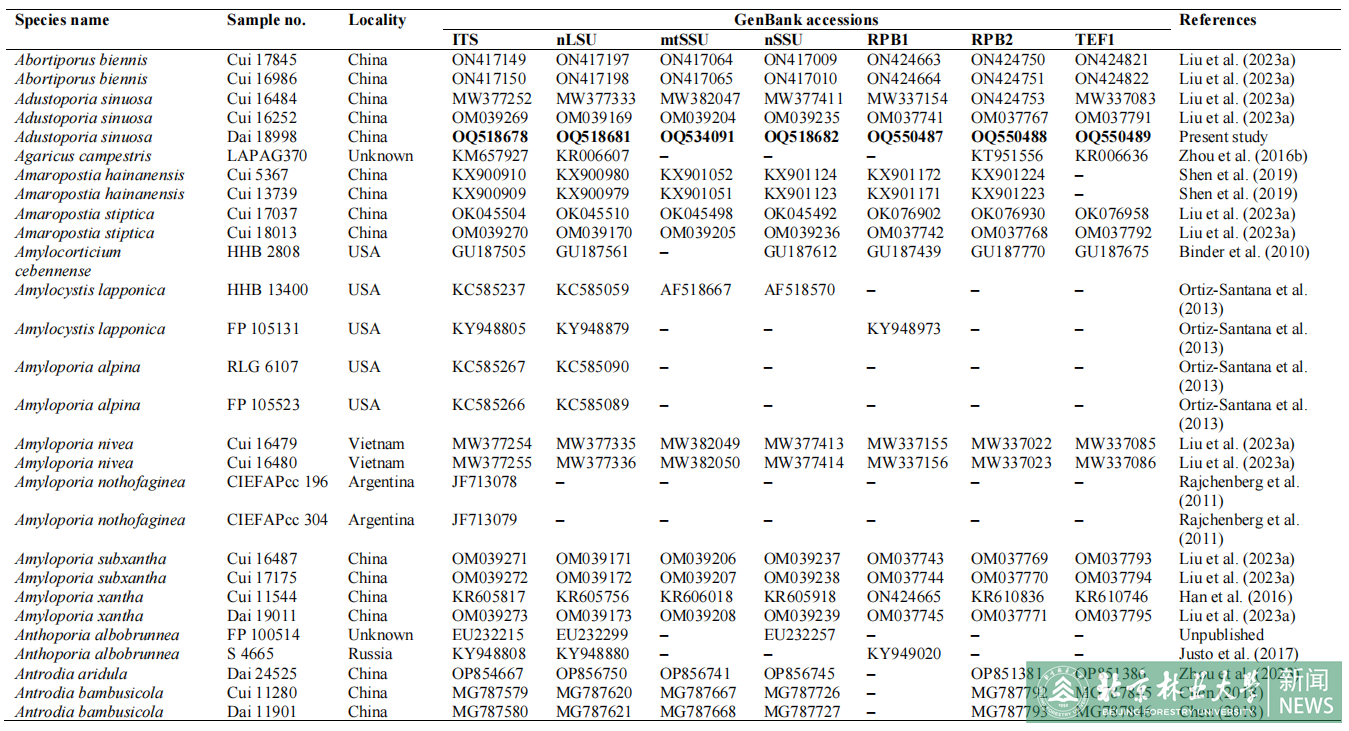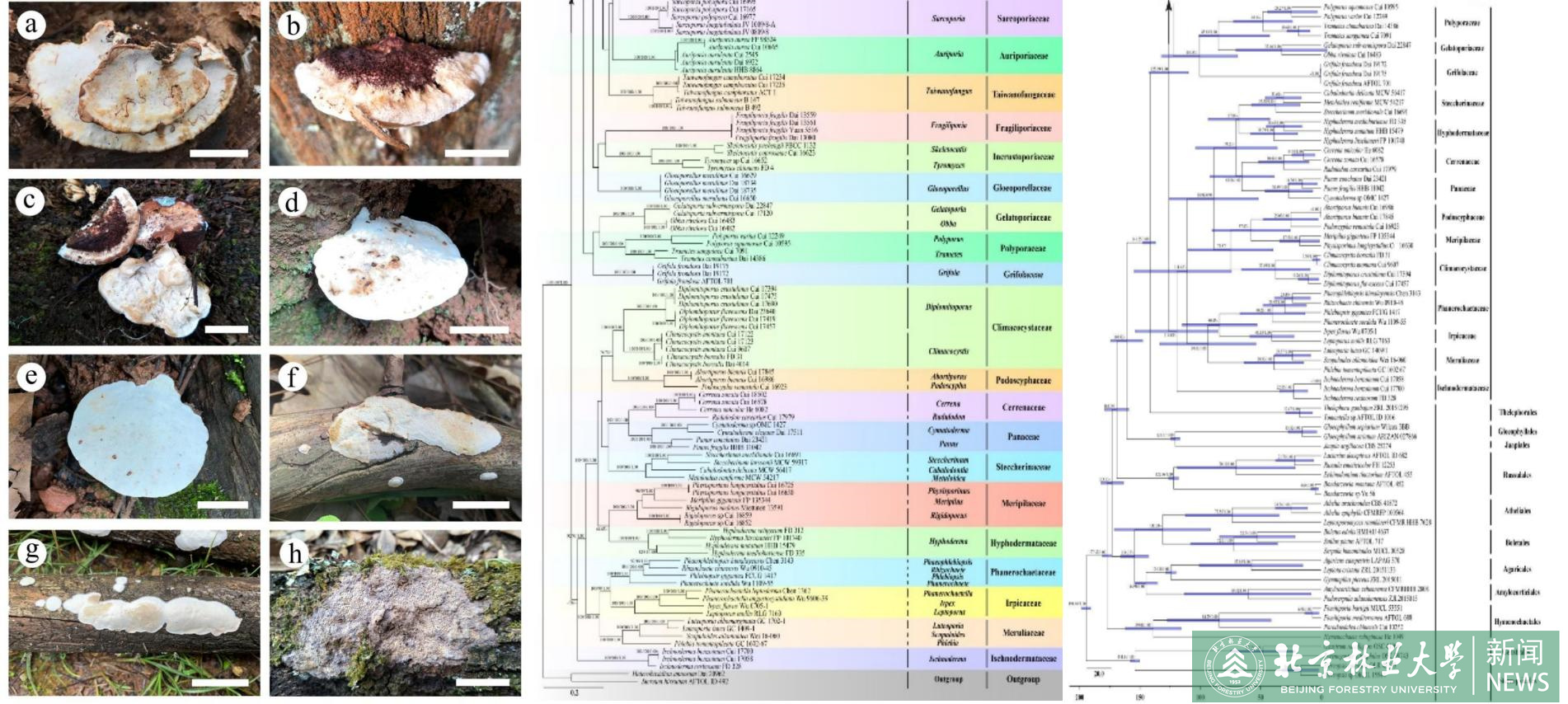Latest news
Recently, Professor Cui Baokai's research group from the School of Ecology and Nature Conservation published a research paper titled “Global Diversity, Molecular Phylogeny, and Divergence Times of the Brown-Rot Fungi within the Polyporales” in the high-impact journal Mycosphere (Q1, IF=16.525). The study presents a comprehensive morphological and phylogenetic analysis of brown-rot fungi within the Polyporales, detailing the species composition and evolutionary history of these fungi.

Wood-decaying fungi can decompose wood plants and produce enzymes to break down the celluloses, hemicelluloses and lignins of wood. Generally, wood-decaying fungi can be divided intotwo types: brown-rot fungi and white-rot fungi. Among them, brown-rot fungi mainly decomposecelluloses and hemicelluloses, which is of great significance to maintain the stability of forestecosystem. Some brown-rot fungi are forest pathogens, which caninfect different parts of wood, such as branch, heartwood, trunk and base; and some are edible fungi or medicinal fungi.

Brown-rot fungi are an important group of wood-decaying fungi, aside from the ecological significance as decomposer and plant pathogens in forest ecosystems, some species are edible and medicinal fungi, which have important economic value. Recent taxonomic and phylogenetic studiesshown that Polyporales contains the majority of brown-rot fungi and forms 14 family-levellineages. However, its species composition and divergence time are not fully understood. In thisstudy, we inferred phylogeny and divergence times of the brown‑rot fungi within the Polyporales.The phylogenetic relationships of the brown‑rot fungi within the Polyporales are reconstructedbased on DNA sequences of multiple loci including the internal transcribed spacer regions (ITS),the large subunit of nuclear ribosomal RNA gene (nLSU), the small subunit of mitochondrial rRNAgene (mtSSU), the small subunit of nuclear ribosomal RNA gene (nuSSU), the largest subunit ofRNA polymerase II gene (RPB1), the second largest subunit of RNA polymerase II gene (RPB2)and the translation elongation factor 1-α gene (TEF1). Molecular clock analysis for the divergencetime of the brown‑rot fungi within the Polyporales is performed using BEAST based on the sevenDNA fragments (ITS, nLSU, mtSSU, nuSSU, RPB1, RPB2, TEF1). Phylogenetic and molecularclock analyses showed that Polyporales appeared in the early Cretaceous (about 141.55 Mya); species of brown-rot fungi within Polyporales gathered and formed 14 family-level lineages, and the differentiation with white-rot fungi occurred in the early Cretaceous (about 119.25 Mya); the brown-rot families of Polyporales were centralized differentiation in the middle Cretaceous (about81.48–99.54 Mya). Through years of extensive field trip investigations, combined with relevantliterature and databases, we concluded that there are 383 brown-rot fungi species within thePolyporales worldwide. Based on the evidence of morphological characters and molecularphylogenetic analyses, 383 brown-rot fungi species within Polyporales belonging to 14 familiesand 69 genera are recognized, including two new genera, viz., Eucalyptoporia and Resupinopostia; nine new species, viz., Daedalea submodesta, D. vinacea, Eucalyptoporia tasmanica, Fuscopostiaavellaneus, F. persicinus, F. tomentosa, Niveoporofomes orientalis, Rhodoantrodia subtropica andResupinopostia sublateritia; and five new combinations, viz., Cystidiopostia simanii, Osteinasubundosa, Resupinopostia lateritia, Spongiporus japonica and S. persicinus. Additionally, an annotated checklist of the species composition, geographical distribution, host trees and somemorphological characteristics of brown-rot fungi within Polyporales is given, based on the field tripinvestigations and published papers.

Liu Shun, a PhD graduate from the School of Ecology and Nature Conservation, is the first author of the paper. Lecturer Sun Yifei and Professor Cui Baokai are the co-corresponding authors. Beijing Forestry University is signature unit of the first author.
The research is supported by the National Natural Science Foundation of China(Nos. 32270010, U2003211), the Fundamental Research Funds for the Central Universities(No. QNTD202307), the Scientific and Technological Tackling Plan for the Key Fields of Xinjiang Production and Construction Corps (No. 2021AB004). The authors would like to express their sincere gratitude to Dr. WenMin Qin from the Institute of Applied Ecology at the Chinese Academy of Sciences, China, for kindly lending them specimens. They are also deeply appreciative of Professor Yu-Cheng Dai from Beijing Forestry University, China, for his invaluable assistance with field collections and for generously providing specimens and photographs.
Paper link: https://doi.org/10.5943/mycosphere/14/1/18.
Written by Sun Yifei
Translated and edited by Song He
Reviewed by Yu Yangyang












